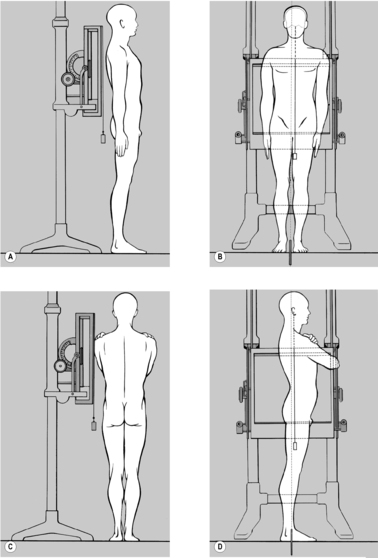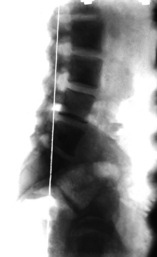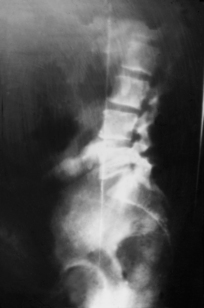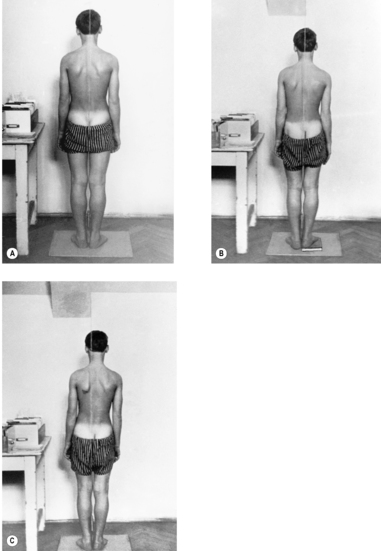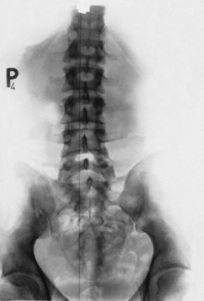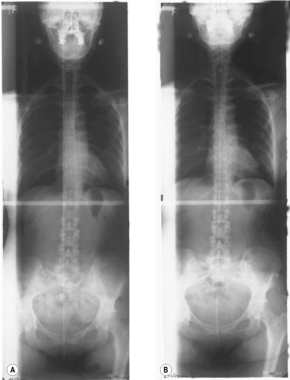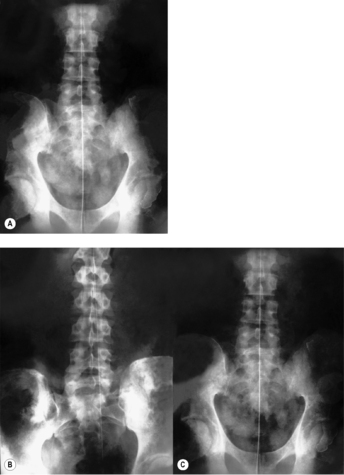The purpose of the films taken in the standing position is mainly to study body statics. The only structures in the frontal plane that can be assessed by clinical examination are the occipital protuberance, spinous processes, iliac crests, intergluteal cleft, and the midpoint between the heels. In the sagittal plane, clinical examination can show the posture of the head, position of the shoulders, the trochanters and the heels in relation to the plumb line, which takes the line from a fixed point at the external auditory meatus. Clinical examination cannot provide information about the position and inclination of the sacrum and the most caudal vertebrae (which mark the true base of the spinal column), information which is essential for a full understanding and evaluation of spinal statics.
This may explain why clinicians interested in body statics have devoted their attention mainly to the question of body equilibrium as a whole, studying deviation of the head and deviation from the line of gravity by means of statovectography. However,
Rash & Burke (1971) pointed out that with static load each body segment should be vertically above the center of the segment on which it rests. The principle is violated if tension of the ligaments or excessive muscular contraction are required to maintain balance. X-ray examination under static conditions provides information on precisely this type of static disturbance.
Lumbar spinal statics in the frontal plane
In the ‘ideal’ case the pelvis and spinal column lie symmetrically in a straight line in the AP view. The external occipital protuberance, spinous processes, pubic symphysis, and coccyx lie in the midline. Such a spinal column is the exception in real life; people simply do not place their weight symmetrically on both feet, but stand in a relaxed posture in which the weight is taken mainly on one leg. During walking, the pelvis constantly swings from one side to the other. The result is the constant creation of oblique planes. The main concern in assessing these is to discover how the spinal column reacts to obliquity in the frontal plane.
The
physiological reaction to obliquity can be seen by performing a test in healthy subjects: the subject must first relax, stand with legs straight, and rest the weight of the body on both feet; a block of wood is then placed under one foot. The subject’s pelvis then shifts to the higher side (see
Figure 3.3).
The radiographic image shows not only the shift to the side, but also scoliosis and rotation to the lower side. The summit of the scoliotic curve is usually at the mid-lumbar region, with the thoracolumbar junction vertically above the sacrum. The degree of rotation depends on the degree of lordosis of the lumbar spine. If there is no lordosis – as is often the case in acute lumbago – there is also no rotation. If there is kyphosis, there may even be rotation to the same side as the concavity.
Reaction by the spinal column to an oblique plane is normal if:
• scoliosis to the lower side results
• there is rotation to the same side (when there is lordosis)
• the thoracolumbar junction is vertically above the sacrum
• the pelvis shifts to the higher side (see
Figure 3.4).
Slight thoracic scoliosis occurs in the opposite direction.
These features reflect normal spinal statics and are closely associated with the problem of
difference in leg length. From the point of view of body statics, a difference in leg length becomes significant only when accompanied by obliquity of the base of the spinal column (see
Figure 3.5).
In the light of this fact, the age-old dispute over how to measure a difference in leg length is beside the point. While it is possible clinically to establish the presence of pelvic tilt, we cannot determine the position of the sacrum relative to the sacral promontory and the lumbar vertebrae that constitute the base of the spinal column proper, as the pelvis may be straight while the sacrum is tilted, or vice versa. The determining factor in spinal column and body statics is the base of the spinal column. The only way to establish the position of these, and find how the spinal column reacts to an oblique base, is by X-ray examination with the patient standing (see
Figure 3.6).
The most important
findings where there is a
disturbance of body statics are:
• obliquity of the base of the spine without scoliosis or with inadequate scoliosis, so that the thoracolumbar junction is not vertically above the lumbosacral
• no lateral pelvic shift to the higher side
• no rotation when there is scoliosis together with lordotic posture of the lumbar spine or even rotation in the direction of the concavity.
The practical decision to be made is whether to order a corrective heel insert. This is primarily a clinical decision, although the X-ray can provide useful clues. The following radiological criteria show when a heel insert can be helpful in the case of obliquity of the base of the spine:
• If scoliosis is not sufficient to bring the thoracolumbar junction into a position vertically above the lumbosacral, or if scoliosis is absent. Use of a heel insert to raise one heel should bring the thoracolumbar junction to the vertical, or at least nearly so.
• If the pelvis is shifted, usually toward the higher side, it should then return to the midline.
• If the scoliosis was statically balanced, it should decrease.
These criteria should all be checked again by X-ray. The spinal column may react positively or negatively to the heel insert, either ‘accepting’ or ‘rejecting’ the correction. If the response is negative it would be wrong to force correction upon the patient, because this would only worsen the situation at the base (see Figure 3.7).
The typical reaction to obliquity as seen radiographically has been studied by
Illi (1954) and
Edinger & Biedermann (1957), with the subject
walking on the spot. At each step, oblique planes appeared together with corresponding scoliosis to the side concerned; the summit of the scoliotic curve appeared at L3. The thoracolumbar junction remained vertically above the sacrum. Above T12 there was a scoliosis of the thoracic spine to the opposite side, but it was shallow. According to
Edinger & Biedermann (1957), the thoracolumbar junction forms a kind of point of interchange, and
should not swing more than 4cm from one side to the other.The relation of the
scoliosis to rotation and its dependence on the presence of curvature in the sagittal plane was studied by
Lovett (1907), who found that rotation of the lumbar spine (in the sense of scoliosis) occurs if lordosis is present, but not in kyphosis. The explanation for this lies in the fact that, whereas the vertebral bodies have good mobility during side-bending, the joints of the vertebral arches are forced together in lordosis and so resist movement. In contrast, in kyphosis there is less close contact between the joints of the vertebral arches; but the vertebral bodies are pressed more firmly against each other, so that these are less free to side-bend. As a result, either there is no rotation at all or rotation occurs in the opposite direction. This is sometimes the case in patients with acute lumbago or in radicular compression syndrome (see
Figure 3.8). The situation can also be found clinically in healthy subjects. On passive side-bending of a subject in lordosis, the spinous processes remain in the midline, and the vertebrae rotate in the sense of scoliosis. If the same is done in kyphosis, the spinous processes form a scoliotic curve: in other words, they move in parallel with the vertebral bodies.
Lumbar spinal statics in the sagittal plane
In the sagittal plane, we often speak of ‘normal’
curvatures; these are generally held to be the convex cervical curve (lordosis), concave thoracic curve (kyphosis), convex lumbar curve (lordosis), and concave sacral curve (kyphosis).
Sollmann & Breitenbach (1961) demonstrated on the basis of 1000 X-ray films in the sagittal plane that there is no such thing as a general norm; at best we can speak of an ‘individual norm.’ They do not, however, lay down any criteria for this kind of norm.
Cramer (1958) showed, on the basis of 150 measurements of the lumbar spine with the subject standing, that there is a constant correlation between the tilt of L5 and that of T12, and more important still, that the T12 vertebra lies an average of 4
cm dorsally to L5. The results of our own study (Lewit 1973) gave complete confirmation of Cramer’s findings and also showed that the plumb line for the head follows a line down from the external acoustic meatus exactly to the navicular bone. We found that the sacral promontory lay an average of 4mm anterior to this plumb line, and the transverse axis of the hip joints 12mm anterior to the plumb line.
Deviations from this norm indicate a
disturbance of body statics as a result of lack of muscle coordination. This is most evident in muscle spasm due to acute lumbago or radicular pain, when there is forward-thrust posture (see
Figure 3.9), in which the thoracolumbar junction lies exactly over or ventral to the lumbosacral junction. The reverse is found in ‘flabby’ posture, in which the sacral promontory lies well forward of the plumb line for the head, and T12 lies dorsal to L5 by some distance (see
Figure 3.10).
‘Flabby’ posture is the expression of imbalance of the muscles of the pelvic girdle; it may be the result of weakened abdominal and gluteal muscles, but equally well of hyperactive hip flexors.
The curvature of the lumbar spine is of course also dependent on pelvic tilt which, in turn, varies according to the ‘type’ of pelvis, as is shown in the following section.
One further point to note is that a slight curvature (a ‘flat’ spine) goes hand in hand with hypermobility and lack of stability, while greater curvature (in both the sagittal and the coronal plane) corresponds to stability and less mobility.
The curvatures of the spine are an expression of static function, and should therefore be interpreted in terms of whether they fulfill this function. In the frontal plane, balance is relatively stable; in the sagittal plane, muscle activity is the determining factor. Curvature of the lumbar spine in the sagittal plane is normal if the thoracolumbar junction is dorsal to the lumbosacral, if there is no forward shifting of the sacral promontory (no more than 8cm in front of the center of the cassette, which is double the average). The position of the thoracolumbar junction vertically above the lumbosacral is also the most important criterion in the frontal plane. If there is obliquity at the base, the normal reaction is scoliosis and rotation of the spinal column (if lordosis is present) and a shift of the pelvis to the higher side.
